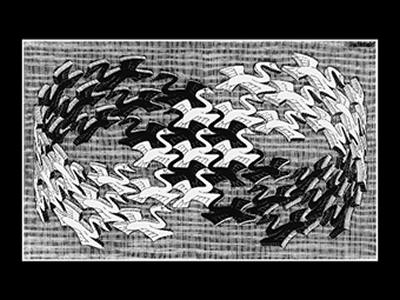Elements of Language and Literature: TROPES
NEXT: Lesson 1 Language Study--Troy's Monologue
 M.C. Escher's Swans. 1956
http://www.math.technion.ac.il/~rl/M.C.Escher/1/moebius_birds.gif |
| What is a Trope? TROPE: [from the Greek tropein, to turn] A trope involves a deviation from the ordinary and principal signifcation (meaning) of a word. Examples include metaphors, similes, and personification. Essentially, a TROPE is the use of language in an unordinary, creative way. A TROPE "turns" the meaning of language in a way. Here's an example: Instead of LAMENTING (whining) to your friends that you failed a test, a common cause of classmate COMMISERATION (empathy) by the way, the use of a TROPE would reassure them of brainwave activity despite the results on the test: "Man, I went down in flames on that test!" You didn't literally fall from your chair in flames during the test but the comment suggests that the results of your attempt were unsuccessful. How? The language "down in flames" references SIGNIFICATION (meaning) from another context, a helpless plane plummeting to the ground; the hopelessness of your attempt is magnified through the use of a TROPE, a METAPHOR in this case. The meaning of "flames" is turned from signifying a literal meaning, "on fire," to signifying something else, "hopelessness."
|
NEXT: Lesson 1 Language Study--Troy's Monologue
